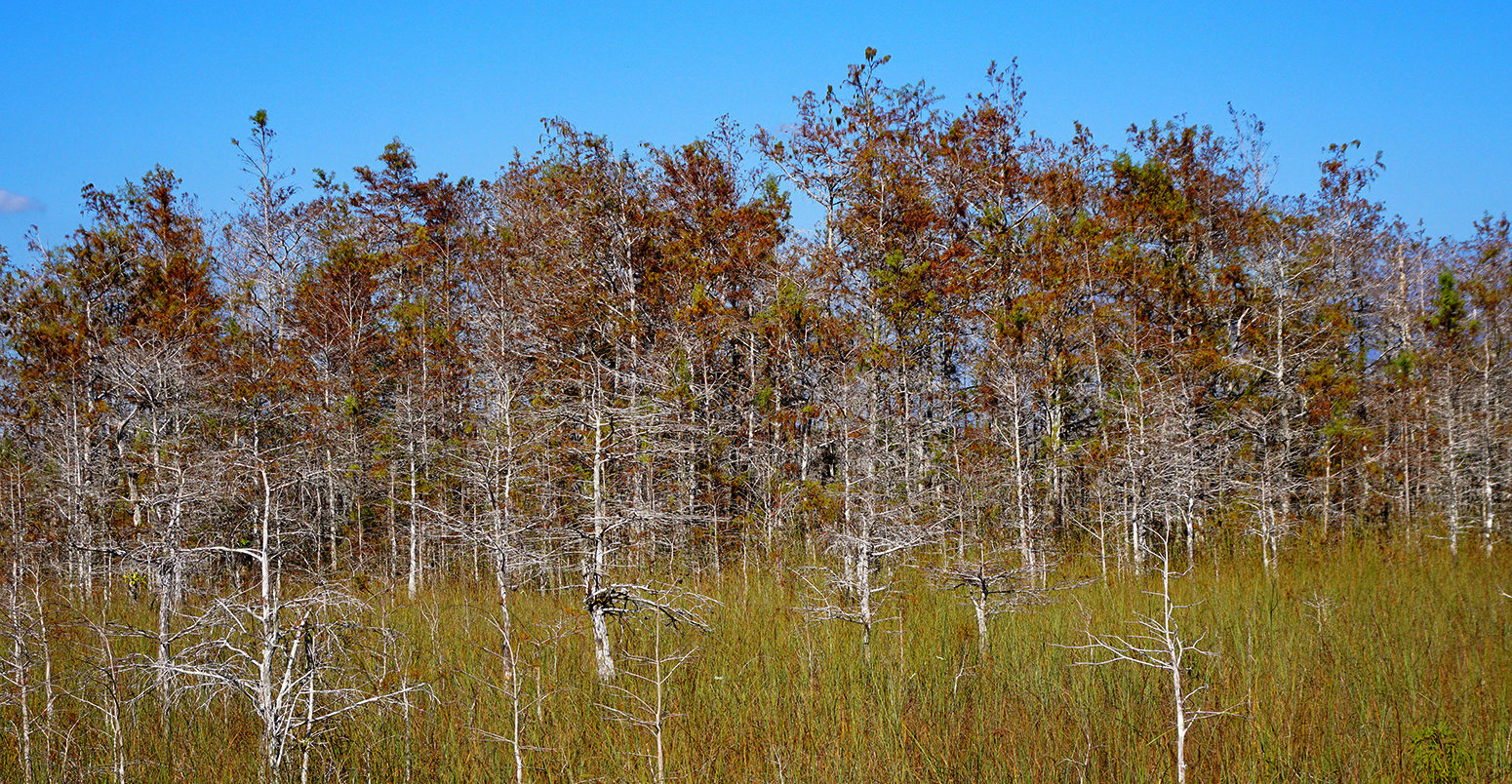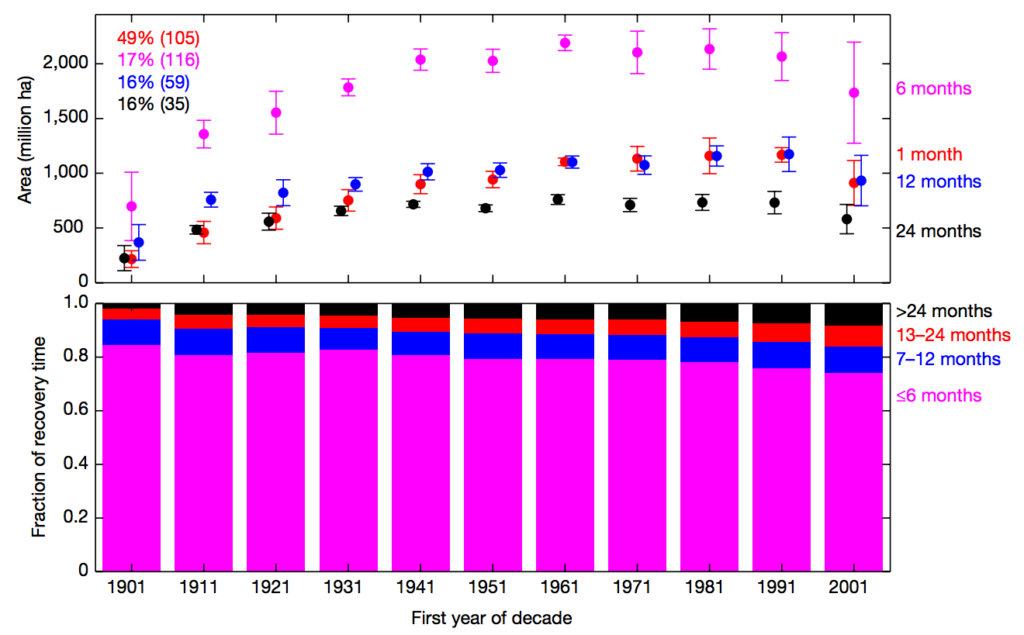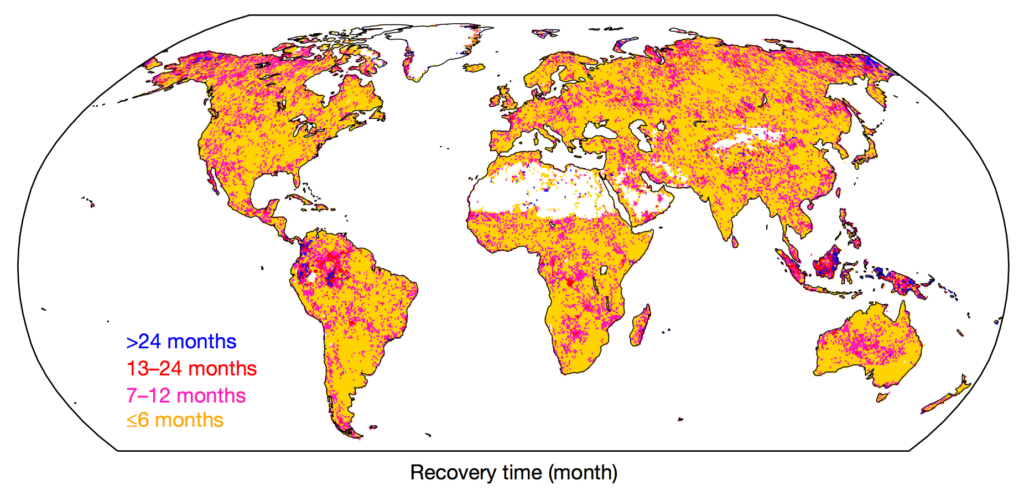
Ecosystems facing ‘double whammy’ due to increasing impacts of drought
Robert McSweeney
08.09.17Robert McSweeney
09.08.2017 | 6:00pmTrees and plants across the world are increasingly in “recovery mode” after a drought, a new study says, and they’re taking longer to bounce back.
The research, published in Nature, maps how much of the Earth’s vegetation is recovering after a drought and how recovery times have changed since 1901.
The findings suggest that “we are likely headed to a new normal where time between droughts is shorter than the recovery time”, the lead author tells Carbon Brief.
This could lead to widespread changes to ecosystems, reducing the amount of CO2 they can take up from the atmosphere, he warns.
Long road to recovery
When the clouds roll in and rain returns to an area parched by drought, it is just the beginning of the recovery. For the plants and trees, returning to the pre-drought levels of growth can take months or even years.
It is this recovery time that the new study tracks. It uses data on vegetation growth (strictly speaking, “gross primary productivity”) from 1901 to 2010.
The data come from three different sources: satellite data (covering 2000-2010), a global network of observational towers that measure exchanges of CO2 and water between the land and atmosphere (1982-2008), and earth system model simulations (1901-2010).
The findings suggest that more of the Earth’s land surface is being affected by drought now than it was a century ago and that recovery times are getting longer.
The upper chart below shows the global average area recovering from drought for each decade since the start of the 20th century. The coloured markers show the area recovering from drought for one month (red), six months (pink), one year (blue) and two years (black).
The numbers in the top-left hand corner pick out the decadal trend for each drought recovery time. All have increased over the 20th century; for example, the amount of land recovering for one month has increased by an average of 49% – or 105m hectares – per decade.

Upper chart: Global average land area (in million hectares) in drought recovery for first year of each decade from 1901 to 2001. Colours indicate time spent in recovery, from one month (red) through to two years (black). The numbers in the top-left show decadal percentage trend for each recovery time (with absolute figures in million hectares in brackets). Lower chart: Proportional split between recovery times for each decade. Note: red shading for this chart indicated 13-24 months recovery time, not one month (as in upper chart). Source: Schwalm et al. (2017)
The rate of increase drops off for the most recent decade. This is because ecosystems aren’t yet recovering from droughts that are ongoing, says lead author Dr Christopher Schwalm, from the Woods Hole Research Centre in the US. He tells Carbon Brief:
“Here it’s the case that droughts have started, but that no recovery has been observed. We can’t ‘see’ these events – but we know there are there – so they pull down the trend.”
Plants and forests are also increasingly spending longer recovering. The lower chart above shows the proportional split between recovery times; you can see that ecosystems are increasingly taking as long as a year (red shading) or even two (black) to return to pre-drought levels of growth.
Recovery is slower when conditions after a drought are unusually warm, the study notes, which suggests that recovery times will get longer as global temperatures rise.
‘Double whammy’
In general, plants react to a lack of water by closing the pores in their leaves to prevent moisture escaping. But with closed pores the plants can’t then take up CO2, which they need to photosynthesis and grow.
As a result, vegetation growth tends to stall in a drought. During the European heatwave in 2003, for example, tree and plant growth fell by 30%. That meant the land surface in Europe actually produced more CO2 than it absorbed that year.
Extended droughts have more extensive impacts, says study co-author Dr William Anderegg from the University of Utah. He tells Carbon Brief:
“Longer-term and more severe droughts can cause loss of the water transport systems in plants, loss of leaf and canopy area, and even mortality.”
Similarly, if a drought starts before an ecosystem has recovered from the previous one, the repeated stress can cause lasting damage, reducing how much CO2 the vegetation can absorb from the atmosphere. Schwalm explains:
“If droughts become more frequent, as expected, the time between droughts may become shorter than drought recovery time, leading to permanently damaged ecosystems and widespread degradation of the land carbon sink.”
Extensive changes to ecosystems is “the main thing that scientists are concerned about”, adds Anderegg:
“For example, a massive mortality of forests, which then become more of shrub or grasslands. This would have huge implications for the carbon stored and other ecosystem services provided to society.”
The researchers have put together a video abstract of the study, which describes the “double whammy” effect of a new drought starting before an ecosystem has recovered from the previous one.
High and low latitudes
The paper also investigates how recovery times vary across the Earth’s land surface.
The map below shows average recovery times following a drought between 1901 and 2010, from less than six months (yellow shading) to more than two years (blue).

Global map of average drought recovery times (in months) for 1901-2010. Shading indicates length of recovery time, from less than six months (yellow) to more than two years (blue). White shading indicates areas that are either water, barren, or that did not experience any relevant drought events. Source: Schwalm et al. (2017)
The tropics and high-latitude regions typically take the longest to recover, the results show. You can see this by the concentration of blue and red shading in, for example, southeast Asia, northern South America, and northern Canada and Alaska.
The tropics take a long time to rebound because they experience droughts relatively rarely, says Schwalm:
“We speculate that high productive regions – think tropics – have little or no history of drought, such that when a drought occurs, recovery is necessarily longer than in a system that has an evolutionary memory of drought.”
In contrast, for high-latitudes, recovery times are slow for more obvious reasons, says Schwalm:
“These systems eke out a very marginal existence, as it were. Such that a drought immediately exhausts any reserves or buffering capacity.”
Testing results
Tracking both where and for how long drought recovery is taking place makes these findings “very exciting” says Dr Trevor Keenan, a scientist in the Climate and Ecosystem Sciences Division at Lawrence Berkeley National Laboratory, who wasn’t involved in the study.
However, it is important to note that the study relies heavily on model simulations, Keenan tells Carbon Brief, and so needs more observed data to add weight to their conclusions:
“It would be good to see their predictions tested with actual observations of ecosystem recovery from drought across a range of ecosystems and climate zones.”
For example, as an accompanying News & Views article by Prof Sonia Seneviratne and Dr Philippe Ciais points out, the study doesn’t include some of the non-climate impacts of drought on ecosystems.
These include damage caused by pests, changes in vegetation that occur after wildfires, and “hydraulic failure” – plant deaths caused by an inability to take up water through their roots.
The study’s results are, therefore, “likely to mainly reflect changes in climate features, rather than the full response from vegetation”, they note.
Schwalm, C. R. et al. (2017) Global patterns of drought recovery, Nature, doi:10.1038/nature23021 Seneviratne, S. I. and Ciais, P. (2017) Trends in ecosystem recovery from drought, Nature
-
Ecosystems facing 'double whammy' due to increasing impacts of drought
-
As the climate warms increasing droughts leave shorter recovery time for trees and plants

